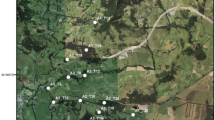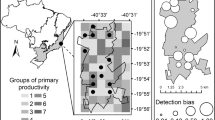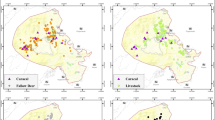Abstract
Here, we present a camera trap survey at a Tibetan sacred mountain to ascertain the status and activity patterns of medium- to large-sized ground-dwelling mammalian fauna. We recorded 15 medium- to large-sized mammal species including 9 carnivores, 4 ungulates, 1 primate, and 1 rodent. Six of the species were categorized by IUCN as globally threatened. The results suggested that the sacred mountain was particularly important for alpine ungulates. The mean occupancy probabilities of blue sheep Pseudois nayaur, Chinese goral Naemorhedus griseus, Chinese serow Capricornis milneedwardsii, and alpine musk deer Moschus chrysogaster were 0.93, 0.91, 0.87, and 0.44 respectively. Domestic dog Canis familiaris also occurs widely across the mountain, with a mean occupancy of 0.60. Temporal activity patterns showed that alpine musk deer were mostly nocturnal, with most captures occurring at night. Chinese serow were active at all periods, with an activity peak at dawn. Blue sheep were strictly diurnal, without any captures at night. Although Chinese goral were predominantly diurnal, captures also frequently occurred at night. Our study not only unveiled a wildlife haven benefiting from religious beliefs about sacred mountains but also pointed to the critical situation of the fauna in the sacred site. The fauna in such sacred sites are diverse but poorly studied, and are subject to threats from domestic dogs, garbage pollution, and population isolation. Future conservation and management efforts in such areas should evaluate the population genetic diversity and assess the impact of non-lethal human disturbance on the wildlife communities.




Similar content being viewed by others
References
Baker L, Olubode O, Tanimola A, Garshelis D (2014) Role of local culture, religion, and human attitudes in the conservation of sacred populations of a threatened ‘pest’ species. Biodivers Conserv 23:1895–1909
Bender LC, Weisenberger ME, Rosas-Rosas OC (2014) Occupancy and habitat correlates of javelinas in the southern San Andres Mountains, New Mexico. J Mammal 95(1):1–8
Bhagwat SA, Kushalappa CG, Williams PH, Brown ND (2005) A landscape approach to biodiversity conservation of sacred groves in the western Ghats of India. Conserv Biol 19:1853–1862
Bhattacharya T, Bashir T, Poudyal K, Sathyakumar S, Saha GK (2012) Distribution, occupancy and activity patterns of goral (Nemorhaedus goral) and Serow (Capricornis thar) in Khangchendzonga biosphere reserve, Sikkim, India. Mamm Stud 37:173–181
Bouyer Y, Gervasi V, Poncin P, Beudels-Jamar RC, Odden J, Linnell JDC (2015) Tolerance to anthropogenic disturbance by a large carnivore: the case of Eurasian lynx in South-Eastern Norway. Anim Conserv 18:271–278
Buffetrille K (1998) Reflections on pilgrimages to sacred mountains, lakes and caves. In: McKay A (ed) Pilgrimage in Tibet. Curzon Press, Surrey, pp 18–34
Burton AC, Neilson E, Moreira D, Ladle A, Steenweg R, Fisher JT, Bayne E, Boutin S (2015) Wildlife camera trapping: a review and recommendations for linking surveys to ecological processes. J Appl Ecol 52:675–685
Buzzard JP, Li X, Bleisch VW (2017) High altitude ungulate communities in Southwest China. https://doi.org/10.1515/mammalia-2017-0019
Dudley N, Higgins-Zogib L, Mansourian S (2009) The links between protected areas, faiths, and sacred natural sites. Conserv Biol 23:568–577
Ens EJ, Pert P, Clarke PA, Budden M, Clubb L, Doran B, Douras C, Gaikwad J, Gott B, Leonard S, Locke J, Packer J, Turpin G, Wason S (2015) Indigenous biocultural knowledge in ecosystem science and management: review and insight from Australia. Biol Conserv 181:133–149
Grolemund G, Wickham H (2011) Dates and times made easy with lubridate. J Stat Softw 40:1–25
Hodge A-MC, Arbogast BS (2016) Carnivore diversity at a montane rainforest site in Ecuador's gran Sumaco biosphere reserve. Oryx 50:474–479
IUCN (2017) The IUCN red list of threatened species. Version 2017-1. <www.iucnredlist.org> downloaded on 04 July 2017
Kéry M, Royle JA (2008) Hierarchical Bayes estimation of species richness and occupancy in spatially replicated surveys. J Appl Ecol 45:589–598
Khorozyan I, Stanton D, Mohammed M, Al-Ra’il W, Pittet M (2014) Patterns of co-existence between humans and mammals in Yemen: some species thrive while others are nearly extinct. Biodivers Conserv 23:1995–2013
Li X, Buzzard P, Chen Y, Jiang X (2013) Patterns of livestock predation by carnivores: human–wildlife conflict in Northwest Yunnan, China. Environ Manag 52:1334–1340. https://doi.org/10.1007/s00267-013-0192-8
Li X, Buzzard P, Jiang X (2014) Habitat associations of four ungulates in mountain forests of Southwest China, based on camera trapping and dung counts data. Popul Ecol 56:251–256
Li X, Jiang X (2014) Implication of musk deer (Moschus spp.) depletion from hunter reports and dung transect data in Northwest Yunnan, China. J Nature Conserv 22:474–478
Liu X, Wu P, Shao X, Songer M, Cai Q, He X, Zhu Y (2017) Diversity and activity patterns of sympatric animals among four types of forest habitat in Guanyinshan nature Reserve in the Qinling Mountains, China. Environ Sci Pollut R 24:16465–16477
MacKenzie DI, Nichols JD, Lachman GB, Droege S, Andrew Royle J, Langtimm CA (2002) Estimating site occupancy rates when detection probabilities are less than one. Ecology 83:2248–2255
MacKenzie DI, Nichols JD, Royle JA, Pollock KH, Bailey L, Hines JE (2017) Occupancy estimation and modeling: inferring patterns and dynamics of species occurrence, 2nd edn. Academic Press, Boston, pp 115–215
Manor R, Saltz D (2004) The impact of free-roaming dogs on gazelle kid/female ratio in a fragmented area. Biol Conserv 119:231–236
Meyer NFV, Esser HJ, Moreno R, van Langevelde F, Liefting Y, Ros Oller D, Vogels CBF, Carver AD, Nielsen CK, Jansen PA (2015) An assessment of the terrestrial mammal communities in forests of Central Panama, using camera-trap surveys. J Nat Conserv 26:28–35
Núñez-Regueiro MM, Branch L, Fletcher RJ Jr, Marás GA, Derlindati E, Tálamo A (2015) Spatial patterns of mammal occurrence in forest strips surrounded by agricultural crops of the Chaco region, Argentina. Biol Conserv 187:19–26
Namgail T, Fox JL, Bhatnagar YV (2007) Carnivore-caused livestock mortality in trans-Himalaya. Environ Manag 39:490–496. https://doi.org/10.1007/s00267-005-0178-2
Niedballa J, Sollmann R, Courtiol A, Wilting A (2016) camtrapR: an R package for efficient camera trap data management. Methods Ecol Evol 7:1457–1462
Plaza PI, Lambertucci SA (2017) How are garbage dumps impacting vertebrate demography, health, and conservation? Global Ecol Conserv 12:9–20
Plummer M (2003) JAGS: a program for analysis of Bayesian graphical models using Gibbs sampling. Paper presented at the proceedings of the 3rd international workshop on distributed statistical computing. Vienna, Austria
Rahel S et al (2017) Quantifying mammal biodiversity co-benefits in certified tropical forests. Divers Distrib 23:317–328
Reilly ML, Tobler MW, Sonderegger DL, Beier P (2017) Spatial and temporal response of wildlife to recreational activities in the San Francisco Bay ecoregion. Biol Conserv 207:117–126
Rich LN, Miller DAW, Robinson HS, McNutt JW, Kelly MJ (2016) Using camera trapping and hierarchical occupancy modelling to evaluate the spatial ecology of an African mammal community. J Appl Ecol 53:1225–1235
Rood E, Ganie AA, Nijman V (2010) Using presence-only modelling to predict Asian elephant habitat use in a tropical forest landscape: implications for conservation. Divers Distrib 16:975–984
Roopsind A, Caughlin TT, Sambhu H, Fragoso JMV, Putz FE (2017) Logging and indigenous hunting impacts on persistence of large neotropical animals. Biotropica 49:565–575
Rovero F, Marshall AR (2009) Camera trapping photographic rate as an index of density in forest ungulates. J Appl Ecol 46:1011–1017
Sarmento PB, Cruz J, Eira C, Fonseca C (2011) Modeling the occupancy of sympatric carnivorans in a Mediterranean ecosystem. Eur J Wild Res 57:119–131
Sasidhran S, Adila N, Hamdan MS, Samantha LD, Aziz N, Kamarudin N, Puan CL, Turner E, Azhar B (2016) Habitat occupancy patterns and activity rate of native mammals in tropical fragmented peat swamp reserves in peninsular Malaysia. Forest Ecol Manag 363:140–148
Shen X, Li S, Chen N, Li S, McShea WJ, Lu Z (2012a) Does science replace traditions? Correlates between traditional Tibetan culture and local bird diversity in Southwest China. Biol Conserv 145:160–170
Shen X, Li S, Wang D, Lu Z (2015) Viable contribution of Tibetan sacred mountains in southwestern China to forest conservation. Conserv Biol 29:1518–1526
Shen X, Lu Z, Li S, Chen N (2012b) Tibetan sacred sites: understanding the traditional management system and its role in modern conservation. Ecol Soc 17:13–24
Silveira L, Jacomo ATA, Diniz-Filho JF (2003) Camera trap, line transect census and track surveys: a comparative evaluation. Biol Conserv 114:351–355
Studley J, Jikmed A (2015) Creating new discursive terrain for the custodians of the Tibetan spirit scapes of north West Yunnan. In: Vershuuren B, Furuta N (eds) Asian sacred natural sites: philosophy and practice in protected areas and conservation. Rutledge, London & New York
Su Y, Yajima M (2015) R2jags: using R to run ‘JAGS’. R package version 0.5–7:available: https://cran.r-project.org/web/packages/R2jags/R2jags.pdf
Tobler MW, Carrillo-Percastegui SE, Powell G (2009) Habitat use, activity patterns and use of mineral licks by five species of ungulate in South-Eastern Peru. J Trop Ecol 25:261–270
Tobler MW, Hartley AZ, Carrillo-Percastegui SE, Powell GVN (2015) Spatiotemporal hierarchical modelling of species richness and occupancy using camera trap data. J Appl Ecol 52:413–421
Zipkin EF, Andrew Royle J, Dawson DK, Bates S (2010) Multi-species occurrence models to evaluate the effects of conservation and management actions. Biol Conserv 143:479–484
Zipkin EF, Grant EHC, Fagan WF (2012) Evaluating the predictive abilities of community occupancy models using AUC while accounting for imperfect detection. Ecol Appl 22:1962–1972. https://doi.org/10.1890/11-1936.1
Acknowledgements
We are very grateful to Paul J. Buzzard for his valuable comments to improve the manuscript. We thank the Baimaxueshan National Nature Reserve Management Office for their kind support. We are also grateful to Yongchun Chen, Jin Lu, Yongsheng Zhang, Qingtao Li, and Bu A for assistance in the field.
Funding
This study was supported by the National Natural Science Foundation of China (31601874), the National Key Research and Development Program (2017YFC0505200), the China Biodiversity Monitoring and Research Network (Sino Bon), the Biodiversity Conservation Programme of China (2110404), and the China Exploration & Research Society (CERS).
Author information
Authors and Affiliations
Corresponding author
Electronic supplementary material
Rights and permissions
About this article
Cite this article
Li, X., Bleisch, W.V. & Jiang, X. Unveiling a wildlife haven: occupancy and activity patterns of mammals at a Tibetan sacred mountain. Eur J Wildl Res 64, 53 (2018). https://doi.org/10.1007/s10344-018-1213-y
Received:
Revised:
Accepted:
Published:
DOI: https://doi.org/10.1007/s10344-018-1213-y




